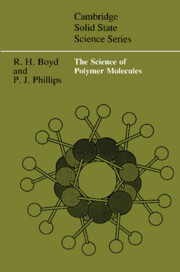Book contents
- Frontmatter
- Contents
- Preface
- 1 Polymerization: an overview
- 2 Molecular weight and molecular weight distribution
- 3 Molecular weight determination
- 4 Polymerization: kinetics and mechanism
- 5 Three dimensional architecture: conformation and stereochemical configuration
- 6 The statistical behavior of conformationally disordered chains
- 7 The interacting bond model for the average properties of coiling chains
- 8 Rubber elasticity
- 9 Solutions
- References
- Index
3 - Molecular weight determination
Published online by Cambridge University Press: 29 October 2009
- Frontmatter
- Contents
- Preface
- 1 Polymerization: an overview
- 2 Molecular weight and molecular weight distribution
- 3 Molecular weight determination
- 4 Polymerization: kinetics and mechanism
- 5 Three dimensional architecture: conformation and stereochemical configuration
- 6 The statistical behavior of conformationally disordered chains
- 7 The interacting bond model for the average properties of coiling chains
- 8 Rubber elasticity
- 9 Solutions
- References
- Index
Summary
There are a number of methods for determining experimentally the molecular weights of polymers. These include both the measurement of number-average and weight-average molecular weights. It will be seen that solution viscosity offers a very convenient method but it is not an absolute method and does not give one of the simple averages. The resolution of molecular lengths into fractions and therefore measurement of molecular weight distribution is also possible experimentally.
End-group analysis
In linear polymers each molecule has two ends so it is clear that a measurement of total numbers of end-groups in a sample of known weight can result in a determination of number-average molecular weight (= sample weight/moles of chains). There is no general method for accomplishing this and essentially the task embraces organic functional group identification in analytical chemistry. An obvious complication is that the method must be very sensitive since the end-groups are present at very low concentrations in high molecular weight polymers. The available methods can perhaps be classified as chemical or physical. Chemical methods would include acid-base titration of acidic or basic end-groups (—CO2H, for example), reaction of end-groups with determinable amounts of specific reagents, and chemical degradation to identifiable products from end-groups. The most prominent physical method and the most useful method in general is probably infrared vibrational spectroscopy.
- Type
- Chapter
- Information
- The Science of Polymer Molecules , pp. 60 - 95Publisher: Cambridge University PressPrint publication year: 1993



